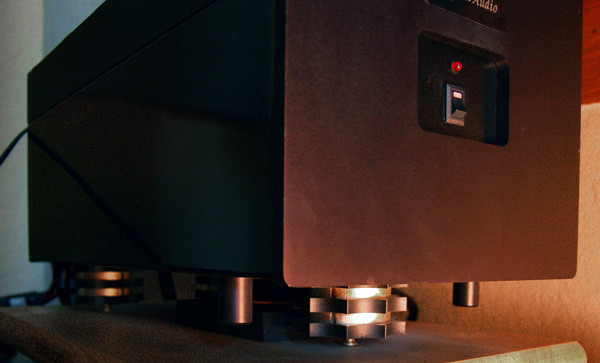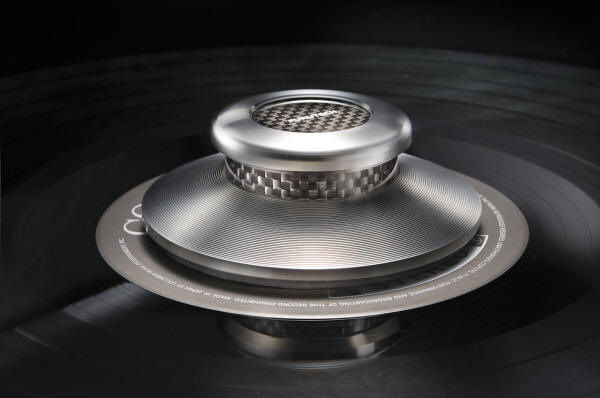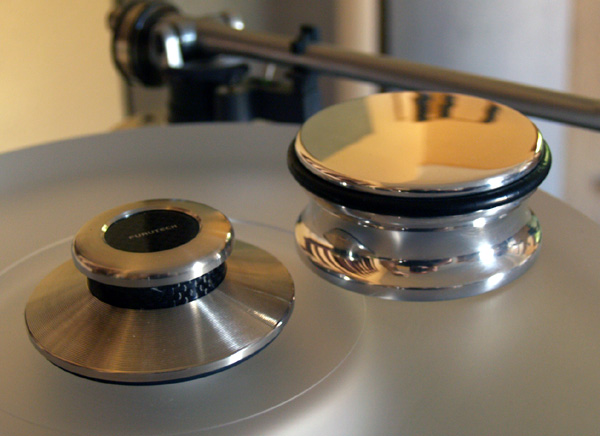|
You are reading the older HTML site Positive Feedback ISSUE 45september/october 2009
Audio Ramblings - the
Marigo VXi Feet and Furutech's Monza LP Stabilizer
This summer has been rather different than prior summers in that Carol has changed positions in the school district to one where we are no longer on the same schedule as w had been prior. This meant that while she was at work dealing with the various failures in the educational system, I was at home dealing with various successes in the audio system. What's that pray tell? Well, for one the Marigo VXi Mystery Feet worked wonders under the Clayton M200s in ways that were simply spectacular in how the music was, well… better. Better in terms of openness, dynamics, clarity, pace, and involvement—in much the same ways that the TRi Feet yielded similar sonic improvements when used with the Cary 306 Professional player. Of course, as you might recall from that Ramblings, these same feet were a definite No No when used under the Playback Design MPS-5 player. In that situation, the TRi Feet went way over the top in these same sonic areas resulting in a spectacular presentation that was ultimately rather fatiguing over the long term. Too much of a good thing with the MPS-5, but just right with either the Cary 306 and now the Clayton M200 amplifiers. Huh? What's going on you ask? Well, different case-work, different mass, different whatever that makes one set of feet perfect and another such a poor match. At least that is all I can come up with at the moment. Of course much of this is personal preference and just as much, system synergy or matching. The VXi Feet are such an excellent match under the Claytons that I simply can't listen without them. The music just looses that magic that I am now accustomed to when listening to whatever is spinning at that moment. Yeah, the system sounded quite nice prior to their insertion so this is not to suggest that it had originally sounded bad—you just don't know what you are missing till you go to the next level! And the Marigo Audio labs VXi are the next level. Not cheap by any stretch of the imagination—audio or otherwise—they do work as advertised ($799.00 for a set of 3 or in my case $1600 for the two amplifiers! Damn monoblocks!).
Marigo VXi feet front center and left/right rear Like I said earlier, the music has a greater sense of openness and clarity without becoming an artificial representation of what the artist proposed. There is no shift to a tonal leanness or that of a bleached out presentation lacking the proper harmonic color-fullness that would make the music, well… less involving or fatiguing. I have found that it is hard to get one without the other—want warmth, color, and richness along with resolution, neutrality, openness, and detail? Well then you've got to accept that to get the former, you need to sacrifice (to varying degrees) the latter. Under the Claytons we get all the benefits or more of those sonic qualities that we want in our music with none of the trade-offs that going in such direction can bring about… way cool. We are hearing more resolution or information with less blur, boom, and 'noise' to get in the way. The VXi Feet are best described as sonic cleaners—they remove 'things' that obscure one's music. With the VXi Feet, we are realizing all the sonic benefits of the Claytons with none of the amplifiers perceived downsides (a potential to be a bit 'darker' than 'lighter' if you know what I mean). Nice. Mr. Levi has written about these in a past issue (https://positive-feedback.com/Issue40/marigo.htm), so read his comments to learn a bit more, or call Ron at Marigo and he can go even further in telling you what he is doing with this wonderful feet. Simply put, the VXi Feet have allowed for less harmful resonances to get in the way of what our amplifiers can do, and that is to make engaging music. But try as you go since there appears to be no silver bullet when it comes to a component and what works best as an 'isolation' or a device to its address resonances (either its own or those from the environment).
Still spinning those black discs from years gone by? Not black CDRs but real 'vinyl' black discs… you know records? What you say… yeah sure (heck even my 21 year old son prefers vinyl over digital which is why he is now buying records when he can—he owns a turntable!). But have you tried any record clamps lately? Say what? Well clamping a record to the platter can yield great benefits, and how it is done will defiantly has it influences. My Transrotor Leonardo came with an elegant chrome clamp (not a standard option but an upgrade that I went for) that is a relatively heavy affair which settles down onto the record and does what one should do: adds mass to dampen resonances and such when spinning vinyl. It works (vinyl sounds better with than without in all the appropriate ways) and not having anything to compare it to, well… it was as good as it gets till I tried Furutech's Monza ($495). Now while the Transrotor clamp appears to just be mass-adding device, the Monza is a completely different beast altogether; what else would one expect from the boys at Furutech? No, Furutech likes to really push the envelope. That is they go WAY beyond what anyone else is doing and explores areas that one would never expect to be an issue. Like what they have done with making a record clamp, or as they prefer, a record stabilizer. To quote for their press release: "The beautifully finished precision machined nonmagnetic stainless steel base and top modules are separated by a layer of damping carbon fiber. The bottom surface is covered with 16 concentric cushioning grooves made of an extremely effective Piezo Electric damping material. It was developed for the Innovations award-winning FI-50 connector series. In that "active technology" system Furutech engineers created a unique material comprised of nano-sized ceramic particles and powdered carbon. Nano-ceramics couple with carbon powder create the piezo effect. Nylon and fiberglass are added in the connector, and the whole forms an extremely effective mechanically and electrically damped matrix. Piezoelectric effects are the key. The nano-polycrystalline ferroelectric ceramic particles exhibit electro-generative properties (mechanical pressure creates an electrical charge) and the carbon powder exhibits thermal-conductive characteristics. The mechanical and electrical damping effects occur while "interconverting" thermal, mechanical, and electrical energy."
Furutech Monza on the left and the Transrotor on the right Marketing rhetoric? Well, if it didn't make a difference, then well… maybe. But yikes, music with the Monza Stabilizer is so much better than what had been heard with the Transrotor clamp that they HAVE to be on to something here. Prior to the Monza, the Transrotor did sound quite nice, but yeah, music had a sense of leanness or lightness to it—it would be nice to have a tad more weight to the bottom-end along with a touch or two more warmth and richness to the upper bass and lower mids. Well, no… make that vinyl without the Monza was lacking in 'color', richness, and weight. Yeah it sounded good, really good and in many ways still better than the better digital, but too many records lacked a certain degree of fleshy-richness or 'color' and weight—all of which would be a nice addition. Is this more of a characteristic of the table itself (no doubt being based on acrylic is responsible to a degree), or the cartridge (the Shelter 901 which being an MC is also responsible to a degree), or the phonostage (the Sutherland PhD which being from Ron is also responsible to a degree)—but since we prefer a more upfront open sound then, well… we got what we wanted. Of course one can change and now find yourself wanting a wee bit less of this and a whole lot more of that—that missing weight and tonal richness or warmth that as we get older sounds nicer. Which is not to be confused with being way more dark and tonally lusher—no, that we aren't after. We aren't after those SET euphonic colorations that make things mush and mash—nice and listenable, but too bloated and tonally fat for the long run. But a bit more of that darker, lusher, weightier quality added into the mix, yeah… that would be the ticket. Like I said earlier about the Claytons when mated to the Marigos… it would be nice if we could have it all. Well, with the Monza I think we are getting pretty close. Plop it on a record and yeah, things clearly become heavier, weightier… meatier. There is more flesh or fat to them musical bones (one should not have just muscle or flesh, you do need some fat!), and more weight and oomph to the bottom-end. The music now has more tonal heft and fullness with none of those potential tradeoffs—that evil bloat and over-the-top richness that makes things appear to be less resolving or open than they really are in their absence. Cool. With the Monza, we still get the resolution along with a neutral tonal color and all that vinyl goodness… wow, the Monza is nice step in the right direction. It clearly mitigates any of the shortfalls in the analog system that I had mentioned above. With the Monza we are get it all and in spades! It is easy to swap in and out to realize what it is doing (and the Transrotor clamp is not doing). It works as advertised and is a clear winner. Furutech http://www.furutech.com Marigo Audio labs http://www.marigoaudio.com
|




